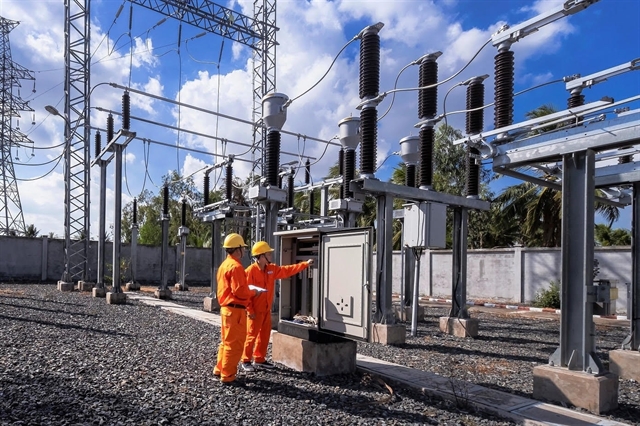The electricity price rise was the second adjustment since 2023, bringing the total increase in the past three years to more than 17 per cent.

Compiled by Thu Hà
HÀ NỘI — The recent electricity price increase is necessary, but it should be accompanied by a long-term and transparent roadmap, experts said.
Việt Nam Electricity (EVN) has raised the average retail electricity price by 4.8 per cent since May 10 this year. Accordingly, the average electricity price has increased from VNĐ2,103.12 to VNĐ2,204.06 per kWh, excluding value added tax (VAT).
This was the second adjustment since 2023, bringing the total increase in the past three years to more than 17 per cent.
According to Dr Ngô Trí Long, former Director of the Ministry of Finance’s Institute for Price and Market Research, although this electricity price increase is a technical step according to the market mechanism and financial requirements of the electricity industry, the rise has a strong ripple effect on all economic and social activities.
It poses many challenges in controlling inflation, restoring production, stabilising people's lives and shaping long-term energy strategies.
Long said that, according to estimates by the General Statistics Office, this electricity price change will cause the consumer price index (CPI) to increase by about 0.09 percentage points. Although it has not created an immediate shock, the fact that electricity prices are adjusted quarterly, with each time increasing by two per cent or more, shows that the risk of accumulating inflationary pressure is clear, especially in the context that prices of many other items such as gasoline, food and tuition fees are also on the rise.
Long added that the electricity price hike will create a cost burden that weighs on the recovery of businesses, especially in large electricity-consuming industries such as metallurgy, cement, chemicals, mining and frozen foods.
"In the context of export difficulties due to weakening global demand and thin profit margins, the increase in electricity prices continues to erode the competitiveness of Vietnamese enterprises in the international market," Long said.
The domestic supply chain is also affected, Long adds, explaining that when production costs increase, output prices are forced to adjust accordingly, causing the opposite effects of rising input inflation pressure and decreasing domestic consumption. This prolonged impact can hinder the recovery of production and business after the pandemic.
In addition, Long said that an electricity price hike can change consumer behaviour and increase the risk of energy inequality. He explained that a positive aspect of the price increase is that consumers tend to save more electricity, switch to high-efficiency equipment and limit consumption during peak hours. This is a positive signal for encouraging consumers to be more sustainable in their energy behaviours.
However, for the poor, often in remote areas, where they do not have access to energy-saving technology, the price increase will cause a decline in quality of life and increased inequality in energy access.
According to the former Deputy Director of the Hanoi Department of Trade, Vũ Vinh Phú, the electricity price hike is necessary in the context of limited supply and higher input costs. However, the adjustment must have a reasonable roadmap, instead of rising every three months as currently, to avoid creating additional burdens for people and businesses. He cited the electricity price adjustment in some other countries as an example.
“In Poland and Germany, they have a plan to increase electricity prices for five years. With the long-term plan, enterprises can proactively plan their production and business, while individuals can also plan their power consumption in advance,” Phú said.
Besides, Phú said, the increase in electricity prices must be transparent. The EVN must disclose its revenues, expenditures, losses and profits.
Sharing the same view, Chairman of the Vietnam Textile and Apparel Association, Vũ Đức Giang, said that the electricity price increase is inevitable, and society and businesses must share this with the electricity industry. However, there should be a longer roadmap for the increase.
“If the electricity price increases in a short time of every three months, it will cause many difficulties for enterprises, because they will not be able to proactively calculate the cost of a product. When the enterprises calculate and negotiate prices with their partners, they must have stable and proactive plans,” Giang said.
Besides, Giang said that the electricity price hike will contribute to increasing the cost of goods, while Vietnamese goods are already weaker than those of other countries in terms of technology and human resources. For the textile and dyeing industry, the input cost of electricity accounts for 9-12 per cent of the product cost. For the garment industry, the number is more than 1.8 per cent.
According to Dr Long, a fair, transparent and effective energy strategy is needed to ensure the country’s energy security.
“It is necessary to publicise the electricity price structure and input costs for each type of electricity (hydropower, coal-fired power, gas-fired power and renewable energy) to facilitate the supervision,” Long said.
In addition, Long believes it is necessary to accelerate the roadmap for a competitive electricity market to increase transparency and reduce monopoly.
The Government should also consider establishing a power stabilisation fund or an energy support fund for low-income people to contribute to ensuring social equity, he said. — BIZHUB/VNS
- Tags
- electricity





